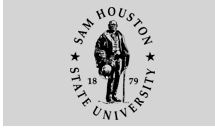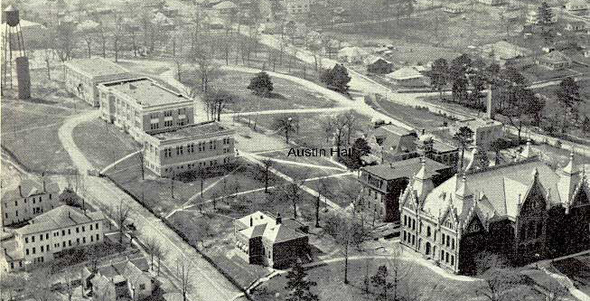 |
This view of the Sam Houston State Teachers
College campus from the northeast in about 1927 shows the
historic triumverate of Old Main, Austin Hall, and the
Peabody Building lower right. |
Austin Hall--A True Beacon of Learning
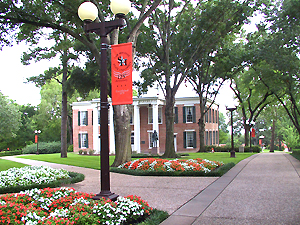 |
Austin Hall in 2004 |
The Sam Houston State University campus landmark--Austin
Hall--may
seem like just another old building, until you consider what
it has been through and what it stands for.
First used in October, 1852, Austin Hall is the oldest continuously-used
state-owned higher education facility west of the Mississippi.
Events in Austin Hall's long history reflect the importance
of education to the people of Texas and the citizens of Huntsville,
and the struggle and effort necessary to achieve it.
General Sam Houston lived just down the hill from Austin Hall,
on what is now a part of the Sam Houston State campus, which
might have been a geographical accident. But his interest and
involvement in the early history of Austin Hall are evidence
that he was concerned with more than matters of war and state,
but also of education.
General Houston helped dedicate Austin Hall on June 24, 1851,
holding an umbrella to shade the speaker on that occasion. He
was also a member of the first board of governors of Austin College,
the Presbyterian school which first occupied the impressive Tuscan-columned
building.
The building was first occupied in October, 1852, even before
it was finished. When completed in 1853, Austin Hall's hilltop
location enabled it to be seen at night from an estimated 18
miles away--a true beacon of learning.
Austin College's early years were not easy, however. It went
through a change in leadership in 1853 after its first president
and General Houston had a falling-out over a jointly-owned corn
crop, and other matters.
The college also struggled financially. It established the first
law school in Texas in 1855 in an attempt to increase its prestige
and fiscal condition, but gave up the law school two years later.
In 1858 there was a disagreement between faculty and students.
The faculty objected to a plan by the seniors to hold a graduation
dance. The dance was held in defiance, off-campus. The faculty
retaliated by withholding the seniors' degrees. Enrollment suffered.
The degrees were finally awarded in 1859.
The War Between the States, an 1864 smallpox scare, and an 1867
yellow fever outbreak further reduced enrollment. The International
Great Northern Railroad bypassed Huntsville, and the Presbyterians
decided in 1874 to relocate their college to Sherman, Texas.
The Methodist Church acquired Austin Hall in 1877 for $1,000,
with plans to use it as a school for boys. That effort failed,
however, and the church was happy to sell the building to Huntsville
citizens for $346.
Influenced by the Huntsville community's offer of a free facility,
and with assistance from the Peabody Education Fund, the Texas
Legislature located the state's first school for training teachers--a "normal" school--in
Huntsville. Sam Houston Normal Institute was created on April
21, 1879, and opened for classes on
October 10th of that year.
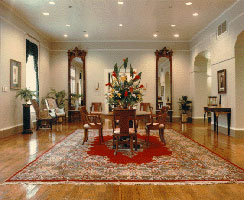 |
Austin Hall's Reception
Area |
The Institute's first catalogue, which was not published until
after the close of the first academic year, listed a "Board
of Instruction" that included: H. H. Smith, principal; Oscar
H. Cooper, assistant; Mrs. Bernard Mallon, assistant; Mrs. J.
R. Whiteside, assistant; and Mrs. A. A. Reynolds, music. Cooper
was also listed as the librarian, and Mrs. Whiteside as secretary.
That catalogue also listed the names of 109 students.
Unlike its predecessor institutions, Sam Houston Normal prospered.
In 1881 Austin Hall's cupola was removed so that a third floor
could be added to provide more space. By the end of its first
10 years of operation, in 1888, the Normal had grown to an enrollment
of 300, and it became necessary to construct a larger building.
Thus it was that Old Main was built, beginning in September,
1888, with completion and dedication in September, 1890. Historians
believe that the proximity of the two buildings may have indicated
a plan to remove Austin Hall, but it was never done.
The addition of Old Main also allowed another year of study
for students wishing to stay beyond the traditional two-year "normal" program.
The small but growing campus soon had another addition. The
Peabody Memorial Library was built just east of Austin Hall in
1902--the first library building at an institution of higher
education in Texas. It was so named to commemorate contributions
of the Peabody Education Fund to the operating budgets of Sam
Houston Normal Institute from 1879-1904.
The Sam Houston State curriculum was expanded to four years
in 1918. The name of the school was changed to Sam Houston State
Teachers College in 1923.
Austin Hall's third floor was removed during the 1926-'27 academic
year, and occasional minor modifications were made from that
time until February 12, 1982, when a fire destroyed Old Main
and damaged Austin Hall.
In those intervening years Sam Houston State continued to grow.
In 1965 its name was changed to Sam Houston State College, and
in 1969, to Sam Houston State University.
Old Main, with its elaborate and memorable Gothic spires, was
not rebuilt after the 1982 fire. Instead, a memorial footprint
of the structure was completed and dedicated in April, 1987.
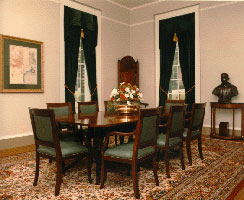 |
A Side Room for Meetings
and Socials |
Although severely damaged, the more graceful Austin Hall was
restored, complete with its bell-tower cupola. Scores of student
names, carved over the past century or more in its soft sand
bricks, were saved.
Austin Hall's Greek Revival architectural style was complemented
by Early Federal and Empire furnishings, making the building
an historical showplace. It was re-dedicated in October, 1986
and is used for university receptions, meetings, and special
events.
It also serves as a reminder of the hopes, dreams, and history
of early Texans, and is the architectural symbol of Sam Houston
State University--a great name in Texas education.
—END—
SHSU Media Contact: Frank Krystyniak
Edited Jan. 19, 2006
Please send comments, corrections, news tips to Today@Sam.edu.
|


